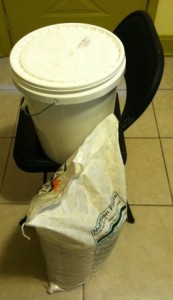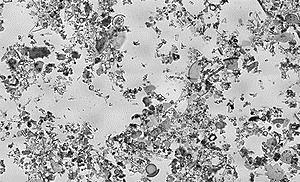It was a bright sunny morning on the infamous day of macabre happenings. My 19 year old son Samuel called me on the phone while I was at work. With a startled and somewhat frantic voice he said, “Dad, there are little black bugs all over Bruce’s room, and I mean ALL OVER!” (Bruce is a friend of the family and lives with us.) “They’re all over; in his bed on the walls… everywhere!” He said. “We looked up bugs on the Internet and they don’t look like bedbugs but they’re all over!” I asked Sam to describe them for me. He said, “It has one antenna on its head and two antennas that come out of the one!” His description made me think that we might be in the midst of an alien invasion!
I told him that I didn’t know what they were but to get all of the clothes off of the floor and drag all the stuff out of the room and spray it well with an insecticide. Every so often we will be invaded by Fire ants (as can happen in the Deep South) but this apparently was different. He said that Bruce, while pulling stuff out of the room, had discovered a high concentration of bugs beneath his bed. He said that they had just drug out a 50 lbs bag of wheat and discovered hundreds of bugs. I remembered that I had stored a bag of wheat under Bruce’s bed so that it would be easier for me to get to it if I wanted to use it for making wheat berries, or to grind whole wheat flour for muffins.
They had already put the bag on the front porch but when Bruce realized a connection they went back out to look in the bag. Sam opened the bag and exclaimed still on his cell phone, “Dad, they’re hundreds of them coming out of the bag! They’re all over the place!” This was confirmation that the bugs in question were weevils. It was, ‘The Day of the Weevil!’ <queue sci-fi music>
After a little research I now know that Wheat weevils (Sitophilus granarius), also known as Grain weevils, are a common pest found all over the  world. They can cause significant damage to harvested and stored grains. The female lays an egg in a kernel of grain, the egg hatches and the larvae begins its journey through the grain eating as it goes. At some point the larvae stage is over (somewhere between 4 and 20 weeks depending on the temperature) and the beetle emerges to mate and start the whole process over again. This must have been what happened with this current weevil invasion. I had purchased the wheat several months ago and the weevils had hatched out and reproduced increasing the population until they either found a hole or gnawed through the bag to escape into Bruce’s room.
world. They can cause significant damage to harvested and stored grains. The female lays an egg in a kernel of grain, the egg hatches and the larvae begins its journey through the grain eating as it goes. At some point the larvae stage is over (somewhere between 4 and 20 weeks depending on the temperature) and the beetle emerges to mate and start the whole process over again. This must have been what happened with this current weevil invasion. I had purchased the wheat several months ago and the weevils had hatched out and reproduced increasing the population until they either found a hole or gnawed through the bag to escape into Bruce’s room.
I have to say that until that day I had not considered weevils to be an issue. I don’t know why, just didn’t. Until then I had always considered weevils to be those annoying bugs that you discover in your cereal, usually after you’ve eaten a couple of bites. With the cereal I could just throw the box away and buy another one but for someone who is storing grain long term I had to reconsider my strategy.
 The process I use to store my grains is called “bucketing.” I purchase large Mylar bags and oxygen absorbers from Amazon, and white general purpose buckets from the local retail store or home fix-it store. I place the bag in the bucket, then the grain in the bag, and then I place an O2 absorber packet on top of the grain in the bag. I can order about 30- 2000cc O2 absorbers from Amazon for around $20.00. I have had it suggested to me that I could buy food grade buckets with gasketed lids and thereby saving the cost of the bag (though these buckets and lids are more expensive than standard plastic buckets and lids) but I am not totally convinced of the permanence of the seal so I am sticking with the bag/bucket method.
The process I use to store my grains is called “bucketing.” I purchase large Mylar bags and oxygen absorbers from Amazon, and white general purpose buckets from the local retail store or home fix-it store. I place the bag in the bucket, then the grain in the bag, and then I place an O2 absorber packet on top of the grain in the bag. I can order about 30- 2000cc O2 absorbers from Amazon for around $20.00. I have had it suggested to me that I could buy food grade buckets with gasketed lids and thereby saving the cost of the bag (though these buckets and lids are more expensive than standard plastic buckets and lids) but I am not totally convinced of the permanence of the seal so I am sticking with the bag/bucket method.
This bucketing process, if done correctly, should minimize damage done to the grain by bugs, unfortunately if the O2 absorber is not large enough to evacuate the bag then insects might continue to feed and breed. There are several additional steps that one can do to decrease the chances of bug survival.
One recommendation is that you bag your grain in the bucket then place a golf ball sized piece of dry ice on top of the grain and leave it until it is the size of a quarter, then seal the bag as before. The science behind this says that since CO2 is heavier than air the CO2 will sink into the bucket and down through the grain displacing the oxygen so that when the bag is sealed not only is the oxygen decreased by the O2 absorber but that what gas is left is not breathable by insects. Be careful during sealing that you don’t allow the bag to suck air back in.
If the two gas options seem too much, a cheap A variation on this is to use a Nitrogen gas tank and a wand. Simply insert the wand to the bottom of the bag/bucket, turn on the knob on the tank and allow the bucket to fill with the gas from the bottom up. Since Nitrogen is also heavier than air the air is displaced leaving little to no air in the bucket. Heat-seal the bag and put the lid on the bucket, and just in case you’re wondering both CO2 and Nitrogen are inert gasses so you should have no worries about explosions.
 Another option is to mix a couple of cups of food grade Diatomaceous Earth (DE) into the grain either before or during the bag/bucket fill, and then finish the bucketing process as before. DE is made from tiny Diatoms (small fossilized algae like creatures) that have extremely sharp edges. The edges are too small to be a problem to humans but they get lodged between the plates of shelled insects and cut the exoskeletons exposing their interior membranes. Once the shell is compromised the air simply dehydrates the bugs and they die. The food grade DE won’t hurt you and when you go to use the grain you can just wash it off like dust. Please remember to get food grade DE since it has no additives. There is also an insecticidal DE that may or may not have added insecticidal chemicals so carefully read the label.
Another option is to mix a couple of cups of food grade Diatomaceous Earth (DE) into the grain either before or during the bag/bucket fill, and then finish the bucketing process as before. DE is made from tiny Diatoms (small fossilized algae like creatures) that have extremely sharp edges. The edges are too small to be a problem to humans but they get lodged between the plates of shelled insects and cut the exoskeletons exposing their interior membranes. Once the shell is compromised the air simply dehydrates the bugs and they die. The food grade DE won’t hurt you and when you go to use the grain you can just wash it off like dust. Please remember to get food grade DE since it has no additives. There is also an insecticidal DE that may or may not have added insecticidal chemicals so carefully read the label.
Food grade DE can be added to chicken feed, or rabbit feed, horse feed- whatever -and will not only help keep bugs from living in the feed but may also kill worms as the DE travels through the animals intestinal tract. DE can also be used in chicken nest boxes or for dust baths to help control mites, and in the garden it can be sprinkled onto vegetable leaves and stalks help to combat hard shelled insects like stink bugs. Again, remember that the only thing I am talking about is food grade DE.
I can’t remember where I got my DE but it was a local home improvement, feed or hardware store since these are the only places I go. I don’t think that I got it from a retail store but that doesn’t mean that you shouldn’t look for it there. Let me just finish with these words- Overall, DE is cheap, safe and has multi-uses, buy some.
There are two ways to stop these bugs, one is to microwave the grain for 5 minutes, and the other way is to freeze it for 24 hours. The first way, though no doubt effective, is not conducive to quick grain storage but the second method has possibilities. The local grain mill operator was just telling me that he thought that he would buy a couple of large chest freezers to do just that very thing for his high dollar feeds.
 I feel that now I must now open a couple of my wheat buckets to see how well my process worked (or should I just use a stethoscope?) either way what will I find? Will I have a bucket of wheat or a bucket of bugs? Remember that if you leave your grain exposed or easily accessible, all grains and grain related products can get infested whether it is a 50 lbs bag of wheat, or an open box of cereal on the top of the refrigerator. Develop discipline in storing your food appropriately, as I am obviously still trying to do.
I feel that now I must now open a couple of my wheat buckets to see how well my process worked (or should I just use a stethoscope?) either way what will I find? Will I have a bucket of wheat or a bucket of bugs? Remember that if you leave your grain exposed or easily accessible, all grains and grain related products can get infested whether it is a 50 lbs bag of wheat, or an open box of cereal on the top of the refrigerator. Develop discipline in storing your food appropriately, as I am obviously still trying to do.
At the end of this creepy yet enlightening event I must decide if using feed grain for long term storage is worth it or not. I do know that the cost of feed grain compared to grain sold in the #10 cans or pre-bucketed is MUCH cheaper, and before you start in- YES, I did think about the possibility of insecticides on the grain and decided that the risk was minimal, especially if I washed the grain before use.
So, if I can kill or otherwise stop the larvae in the seed, AND my methods of storage are adequate to halt the bug growth, then I think the answer is yes. What I absolutely know is this; my prepping journey seems to be full of a never ending amount of learning and I seem to be one of its more inelegant learners.
Cheers,
Tony